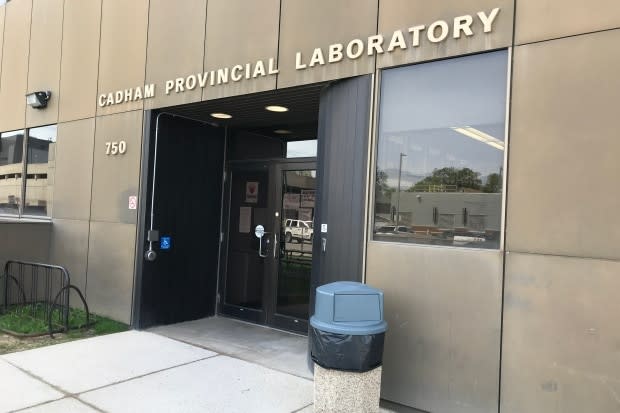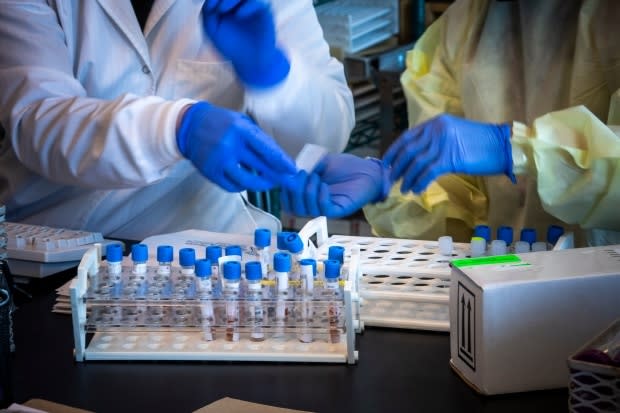COVID-19 not very infectious 8 days after symptoms occur, Winnipeg study suggests
COVID-19 appears to be infectious only for the first eight days after patients experience symptoms, Winnipeg researchers conclude in a study that, if confirmed by further work, could have implications for the way the disease is treated, isolated and prevented.
In the largest study of its kind so far, researchers from the National Microbiology Laboratory, Cadham Provincial Laboratory and the University of Manitoba looked at nasal or throat samples from 90 Manitobans who tested positive for COVID-19 from March 12 to the first week of April.
All of the samples came from patients who were confirmed to be infected with SARS-CoV-2, the virus that causes COVID-19, through polymerase chain reaction (PCR) testing, the most common means of diagnosing the disease around the world.
This type of test extracts a small amount of genetic material and then copies it into quantities that can be more easily identified. The Winnipeg researchers used the same samples to try to grow more of the virus in cell cultures. They succeeded with 26 of the samples, or 29 per cent in total.
There was no viral growth whatsoever in samples taken from patients more than eight days after they became symptomatic, according to study findings published Friday in the peer-reviewed journal Clinical Infectious Diseases.
'Far less likely'
"We found that [when] they went and got a swab done at Day 8 or beyond, those samples were no longer able to grow in cell culture," Cadham Lab associate medical director Jared Bullard, the lead author on the study, said in a interview on Monday.
"If you've had symptoms for eight days or longer, you're far less likely to be infectious for other people."
Viral cultures can take more than a week to grow. That makes them less efficient as a diagnostic tool — but they are better able to predict whether a patient can still infect anyone else, Bullard said.

The Winnipeg study is not the first to conclude COVID-19 is infectious for only eight days after symptoms show up. Bullard said researchers in Germany, working with a smaller sample, reached a similar conclusion in a study published in Nature last month. So did Chinese researchers who employed a mathematical model, he said.
"Scientists and public health officials have observed that patients that have recovered from COVID-19 can have low levels of the virus's genetic material (RNA) detected for several weeks in some cases. This makes decisions around lifting isolation recommendations difficult," said Eric Morrissette, chief of media relations for the Public Health Agency of Canada (PHAC), which oversees the National Microbiology Lab, one of the partners in this study.
"This is reassuring in that those patients experiencing prolonged positivity are unlikely to be infectious."
Defining transmission risk
The findings suggest that the typical recommendation that patients with COVID-19 isolate themselves for at least 10 days after the onset of symptoms is sound, the researchers conclude.
"These results have implications for clinical care, infection prevention and control, and public health. These data can be used to efficiently target case-finding efforts by better defining the period of maximal transmission risk."

The study also found samples appeared to be the most infectious three to five days after patients first experienced COVID-19 symptoms.
Since most patients get tested around Day 6, it becomes relatively easy to target contact-tracing efforts around the most infectious time for any given patient, according to Bullard.
"What this was designed to do was to really assist our colleagues in the clinical practice. They were making decisions about when they felt people could be removed from extra precautions," he said.
'Shouldn't be infectious'
"If somebody's at home in the community, they typically will be at home for 10 days after those symptoms start, and at that point they're free to go out and they shouldn't be infectious to other people. We didn't have the data to support that, and in the hospital we were actually looking at longer."
While the study findings are significant, people respond to infections differently, Morrissette, the spokesperson for PHAC, said.
Larger studies of this kind are needed to investigate patients with potential immune system troubles, people who are hospitalized for a long time, and children, to see if some people may have shorter or longer periods of infectious virus, he said.
However, this Winnipeg study allows public health authorities to be more confident in the practice of requiring returning travellers or anyone who may have been exposed to COVID-19 to isolate at home for two weeks, according to the researchers.
It can also reassure recovered patients and their communities that they no longer pose a risk of spreading the virus to others, Morrissette said.

Manitoba, for now, has no plans to reduce the isolation period of 14 days for returning travellers, other people at risk or anyone diagnosed with COVID-19.
"More work will be needed to review the results of this study, and any larger studies that are conducted, before any policy changes can be made," provincial health authorities said in a statement.
Matching population
The Winnipeg study is particularly valuable in Manitoba, because it reflects so many of the initial cases in the province, which has recorded 292 as of May 26.
"What makes it very applicable here in this province is that you have a population that reflects what we've got, in terms of the different racial distribution and different ages, and … for us that's really quite important," Bullard said.
"It allows us to have the best information possible to make the best decisions."
Kevin Coombs, a University of Manitoba medical microbiologist who played no role in the research led by the provincial and national labs, called the study valuable.
Timeline 'makes sense'
"It separates mere detection of virus components, which may or may not be infectious, from determining actual infectivity, which is much more relevant from a transmission and infection point of view," he said.
Those components include viral RNA that shows up in PCR tests and the viral proteins or antibodies found in serology tests.
"Finding the viral components says nothing about whether they are infectious," Coombs said. "Indeed, viral infectivity tends to decline faster than loss of component detection, so the timeline of about eight days also makes sense."


